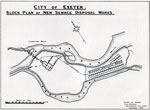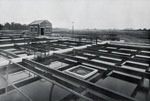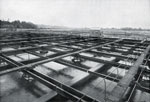
Exeter's Sewage Works - 1931
Page added 12th November 2010
In April 1885, the City Council allocated £150 to experiment with processing sewage on the council site at Belle Isle. The experiment consisted of building some tanks and using 'The material for deodorising the sewage (manufactured) by the maker'. By December of the same year contractors were invited to tender for the contract to construct two 'Disinfecting Tanks' near Trews Weir (Belle Isle). In 1896 two filter beds were added to the scheme, and the works were considered to be no longer experimental – the filtrate, or purified water was discharged into the Exe. Sewage from St Leonard's and part of Heavitree were added to the flow, with a maximum flow of 75 gallons per minute or 32,000 gallons per day. A council meeting reported that 'effluent was seen rushing into the river, looking far clearer than the water into which it flowed, and having no odour whatever'.
By the late 1920s, Exeter's sewage system could not cope with a growing city. At a time of economic recession, Central Government funded schemes across the country to improve infrastructure, and provide work for the unemployed. In 1930, funds were provided to build a new sewage works on land between the canal and the river, below Countess Wear bridge. Similar funds were also provided to construct a new fire station at Danes Castle. The new sewage works were opened in 1931 – these photographs were in the glossy brochure that was published at the time and given to invited guests and dignitaries. The solid product continued to be shipped out from a wharf on the canal and dumped at sea. The last vessel, the purpose built MV Countess Wear made her last voyage on 31st December 1998. 122 ft long, and weighing 93-tonnes, she was built in Poole in 1963. The six-hour, thrice weekly voyages came to an end after EU legislation banned the dumping of sludge at sea. The dry sludge is now used as a soil conditioner. Quotes from the Flying Post.
Back to Photo Essays

 The Sewage Works during a frequent flood
The Sewage Works during a frequent flood
Taken about 2000, this photo shows the sewage works during a flood. The River Exe is on the right and the canal on the left.
 Map of the Sewage Works 1931
Map of the Sewage Works 1931
The map shows the works on the island formed by the River Exe and the Exeter Ship Canal. The pipe work from the city crossed under the river on the left of the map.

 Plan for the Sewage Works 1931
Plan for the Sewage Works 1931
The plan shows the main sewage works where the effluent is processed. Large settling tanks were situated further down the island.
 Concrete Mixing and Distribution Plant
Concrete Mixing and Distribution Plant
The construction was a major public works for 1931. A concrete mixing and distribution plant was located on the island.

 Coffer dam for laying twin 12 in syphon under the Exeter Ship Canal
Coffer dam for laying twin 12 in syphon under the Exeter Ship Canal
This coffer dam across the canal was constructed to allow the installation of twin 12 in syphon pipes from the St Thomas pumping station located near the modern recycling depot in Exton Road. St Leonard's Church spire can be glimpsed in the background.
 Constructing the twin 27 in syphon under the river
Constructing the twin 27 in syphon under the river
The twin syphon pipes under the river from Countess Wear, near Glasshouse Lane, where sunk using a coffer dam.

 54 in C I pipes on piers and commencement of syphon under river
54 in C I pipes on piers and commencement of syphon under river
A large pipe from the city was constructed to carry the effluent to the new sewage works. Here, they approach the river – Glasshouse Lane is in the rear. The point where the pipe enters the ground before it split into two 27 in pipes under the river can be clearly seen.
 Automatically operated pumps - St Thomas Pumping Station
Automatically operated pumps - St Thomas Pumping Station
When Exeter built its first sewage works at Belle Isle in the second half of the 19th Century, St Thomas built their own on land next to what is the City Council Recycling Yard in Exton Road. This is the new pumping station to move the St Thomas effluent for processing at the new sewage works at Countess Wear.

 Electrically operated travelling crane and grab at detritus chambers
Electrically operated travelling crane and grab at detritus chambers
Everything was electrically operated in the new sewage works. Exeter's electricity was generated at Haven Banks.
 Electrically operated mechanically cleaned screens
Electrically operated mechanically cleaned screens
Electrical power was used to automate the processing of the effluent as much as possible.

 General View of sedimentation tanks and screen house
General View of sedimentation tanks and screen house
The sedimentation tanks were followed by the aerating tanks.
 General view of settling tanks and sludge return pumphouse
General view of settling tanks and sludge return pumphouse
Solid matter would settle to the bottom of the settling tanks and the water pumped on.

 General view of aerating tanks
General view of aerating tanks
The aerating tanks added air to the watery effluent to enable the bacteria to break down the sewage.
 General view of works from laboratory
General view of works from laboratory
The laboratory would have checked the quality of the water that flowed out of the end of the works, and also that the solid matter was biologically safe.

 Automatic gear operating return activated sludge valves
Automatic gear operating return activated sludge valves
Another example of the automation installed in the sewage works.
 General view of sludge drying beds
General view of sludge drying beds
The sludge was pumped to the drying beds, which were placed right at the southern end of the complex. Once dry, it was removed and shipped out along the canal to be dumped out at sea.
│ Top of Page │